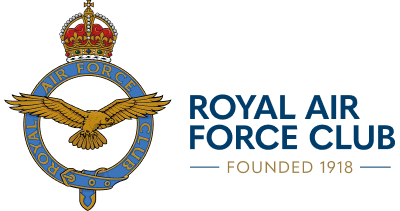Club History
Lord Cowdray & the Founding of the Club
Perhaps appropriately for the new Air Service, out of the blue came a saviour. On 1st October 1918, the first Lord Cowdray offered a gift of £100,000 to provide for a suitable building to house the Royal Air Force Club. Taking on the quest for a suitable building himself, he acquired No. 128 Piccadilly and No 6 Park Lane. 128 had been built between 1887 and 1892, from 1905 housing the Ladies Lyceum Club, whilst No.6 Park Lane housed Livery yards and carriage stables. Cowdray then oversaw extensive refurbishment of the existing building together with a newly built substantial extension on the Park Lane site.
Delayed by post-war shortages, work was completed by the close of 1921. Finally, on 2nd January 1922, the Royal Air Force Club on Piccadilly welcomed Members to their new Club.
In total, the completed Clubhouse had cost Lord Cowdray a remarkable £350,000. Although by 1922 the officer corps had shrunk from 30,000 at war's end to but 2,900, Cowdray was confident that the new Club would have no difficulty in securing a substantial membership from former RFC/RAF officers as well as current serving officers.
Royal Patronage
On 24th February 1922 the Club was formally opened by Group Captain the Duke of York (later King George VI) in a low key ceremony with no press representation. Opening celebrations were completed when on 14th March 1922, King George V and Queen Mary visited the Club, to be shown around by Lord and Lady Cowdray.
The association with the Royal Family continued with Her Majesty Queen Elizabeth II being the Club's Patron from 1952-2022. The Club has since been honoured by His Majesty King Charles III choosing to become our Patron.
1920s and 1930s
Throughout the 1920s and 1930s, the optimism for healthy membership proved unfounded. Even in the late 1930s when re-armament increased the officer corps to 11,500, membership remained stubbornly around the 2,000 mark. Despite regular recruiting drives, the Club's appeal was mainly to retired and London based officers. In one respect however, the Club was revolutionary: it admitted Ladies. Tucked away, and strictly corralled as to time and place and only as guests of members, they were nonetheless on the premises. This breach in the masculine walls of Clubland was the work of Lady Cowdray.
The War Years
Through the war years the Club was more heavily used than ever before, but with no labour nor materials for repair and maintenance the building was in a poor state by 1945. Membership peaked at 2,500 and remained so into the early 50's, when the ending of post-war shortages encouraged a vigorous membership drive which saw a growth to 5,000 members in 1958. In reality it was a false dawn.
The Colonels' Revolt
Nothing was done to make the Club attractive to young officers serving away from London. Ladies, including WRAF officers, were resolutely denied any form of membership. By 1964 membership stood at only 3,800 of whom but 1,500 were serving officers and they were resigning in rapidly increasing numbers. Financially the Club faced bankruptcy. The Committee's solution to this crisis was to increase membership fees and - astonishingly- to seek a buyer who would re-develop the site and would lease back one floor to the Club, creating in effect a Lunch and Dinner club for 2,000 members. A committee dominated by retired London focused members had thus lost sight entirely of Cowdray's vision.
Fortunately two Senior Officers serving in Paris, Air Vice-Marshal Lewis Hodges and Group Captain Neil Cameron, inspired by the family friendly French officers' club, had other ideas. Under their leadership, the so-called 'Colonels' Revolt' was to result in a root and branch reform of the Club. Through their world-wide connections they secured in 1966 enthusiastic support for their proposals to create a club attractive to all RAF officers. So successful was this transformation that by 1976 the membership total of 14,500 represented 75% of the serving officer strength. Female officers were of course full members, whilst wives were given Associate membership.
The Club Reborn
Now truly the RAF Officers' Club, it was granted a Charitable status. This in turn cleared the way for generous assistance by the Royal Air Force Central Fund in financing a thorough modernisation of the Club, family friendly and attractive to all officer ranks. This culminated in 1986 with the purchase of the freehold of No. 128, the Central Fund contributing half the cost. At last, Cowdray's dream was secure, now enshrined as the Club's charitable objective, to provide a Club for serving and retired officers.
In the years since then, successive committees have invested heavily in modernising the building to meet the changing needs of the members. These included the conversion of the basement area into the Running Horse Tavern, named after the public house that stood on the site in the 18th century, a 13-bedroom extension was officially opened in 1990 by the then Vice-Patron, Air Chief Marshal Sir Lewis Hodges, and the most recent, and largest of these investments was the reconstruction of the Squash Courts area, completed to coincide with the Centenary of the Royal Air Force in 2018 and the Queen's visit to the Club on 17th October of that year.
Centenary and The Queen's Visit
On 17th October 2018, the Club's late Patron, Her Majesty The Queen, toured and formally opened the new centenary extension. In the course of a busy schedule, Her Majesty dedicated the new additions comprising a Fitness Centre, the Marshall of Cambridge Business Suite and 17 new bedrooms, bringing the Club's total of bedrooms to 110. She then unveiled the second of the Club's stained-glass windows, appropriately dedicated to Women in the service of the Royal Air Force.
